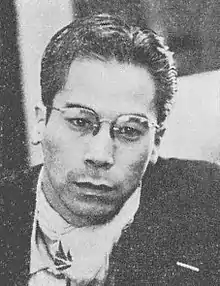Kazuo Yamada
Kazuo Yamada (山田 一雄, Yamada Kazuo, 19 October 1912 – 13 August 1991) was a Japanese conductor and composer.
Kazuo Yamada | |
|---|---|
 | |
| Born | 19 October 1912 Tokyo, Japan |
| Died | 13 August 1991 (aged 78) Tokyo, Japan |
| Resting place | Tokyo, Japan |
| Other names | 山田 一雄 |
| Occupation | Conductor |
Birthday
Born in Tokyo in 1912. Began studies at Gakushuin and then Tokyo University of the Arts (formerly the Tokyo Music School). Studied piano with Leo Sirota and Paul Weingarten, and composition with Klaus Pringsheim, and graduated at the top of his class. Formed the orchestra 'Promethée' as a composer. In 1937 was awarded first prize from the Japan Broadcasting Corporation for his symphonic music works, and in 1938 was also awarded by the New Symphony Orchestra for his symphonic poem 'Songs that youth can sing' as well as the Weingarten Award for the symphonic 'Kiso'. Studied conducting technique under the tutelage of Józef Rosenstock, and premiered as a conductor for the New Symphony Orchestra in 1940. Appointed to the post of chief conductor of the Japan Symphony Orchestra which was reorganized from the New Symphony Orchestra (which is now the NHK symphony orchestra) in 1942, greatly contributing to the improvement of the orchestra for the next 13 years. Awarded the Mainichi Music Award in 1949 for the Japan premiere of the opera Hänsel und Gretel sponsored by NHK. Contributed immeasurably to many Japan premieres of works such as Symphonies No. 2 and No. 8 (Mahler), Symphony No. 5 (Shostakovich), Don Quixote (R. Strauss), Six Pieces for Orchestra (Webern), The Rite of Spring (Stravinsky), Le roi David (Honegger) and Sept haïkaï (Messiaen).
Yamada's activities overseas gradually began to take off from 1955, where he guest conducted European orchestras such as the USSR Symphony Orchestra, Slovak Philharmonic, Dresden Philharmonic, as well as orchestras in North and South America and South Africa, and he moreover recorded with the Vienna Symphony Orchestra in 1988.[1] In 1976, Yamada was awarded the Medal with Purple Ribbon (for artistic excellence) by the Government of Japan, and in 1978 he firmly established his reputation for excellence in the 'World of Kazuo Yamada' series of performances. He was further awarded the Minister of Education Award for Fine Arts in 1979, the Order of the Rising Sun, Gold Rays with Rosette, Fourth Class in 1984, and the Japan Art Academy Award in 1986.
Held a number of key posts such as Chief Resident Conductor & Artistic Advisor of the Kyoto Symphony Orchestra, Artistic Director of the Gunma Symphony Orchestra, Honorary Conductor of the Japan Shinsei Symphony Orchestra, Music Director of the Nissho Chorus, Chairman of the Japan Mahler Society, Professor of the Tokyo University of the Arts, and gave stellar performances as Guest Conductor in Japan as well as overseas. Appointed to the post of Music Director of the Kanagawa Philharmonic in 1991 until his sudden demise on 13 August in the same year at 78 years of age.
A live recording of Yamada conducting Symphony No. 9 (Mahler) with the New Japan Philharmonic was released in 2011, a quarter-century after the 1986 performance, which was awarded the Grand Prize for recording in the Arts Festival of the Japan Ministry for Cultural Affairs.
Major works
- Violin Sonata
- Sonata for Cello Solo
- String Quartet No. 1
- Notturno for flute and piano
- From Soshigaya for voice and piano
Footnotes
- Although the book authored by Kazuo Yamada entitled Ichi-on Hyaku-tai [One sound, one hundred forms] states that a broadcast recording with the NBC Symphony Orchestra was made in New York in 1959. However, since this orchestra's exclusive contract with NBC had been dissolved upon the retirement of Toscanini in 1954, the orchestra conducted by Yamada is presumed to had been the one renamed as 'The Symphony of the Air' following the dissolution of the contract.